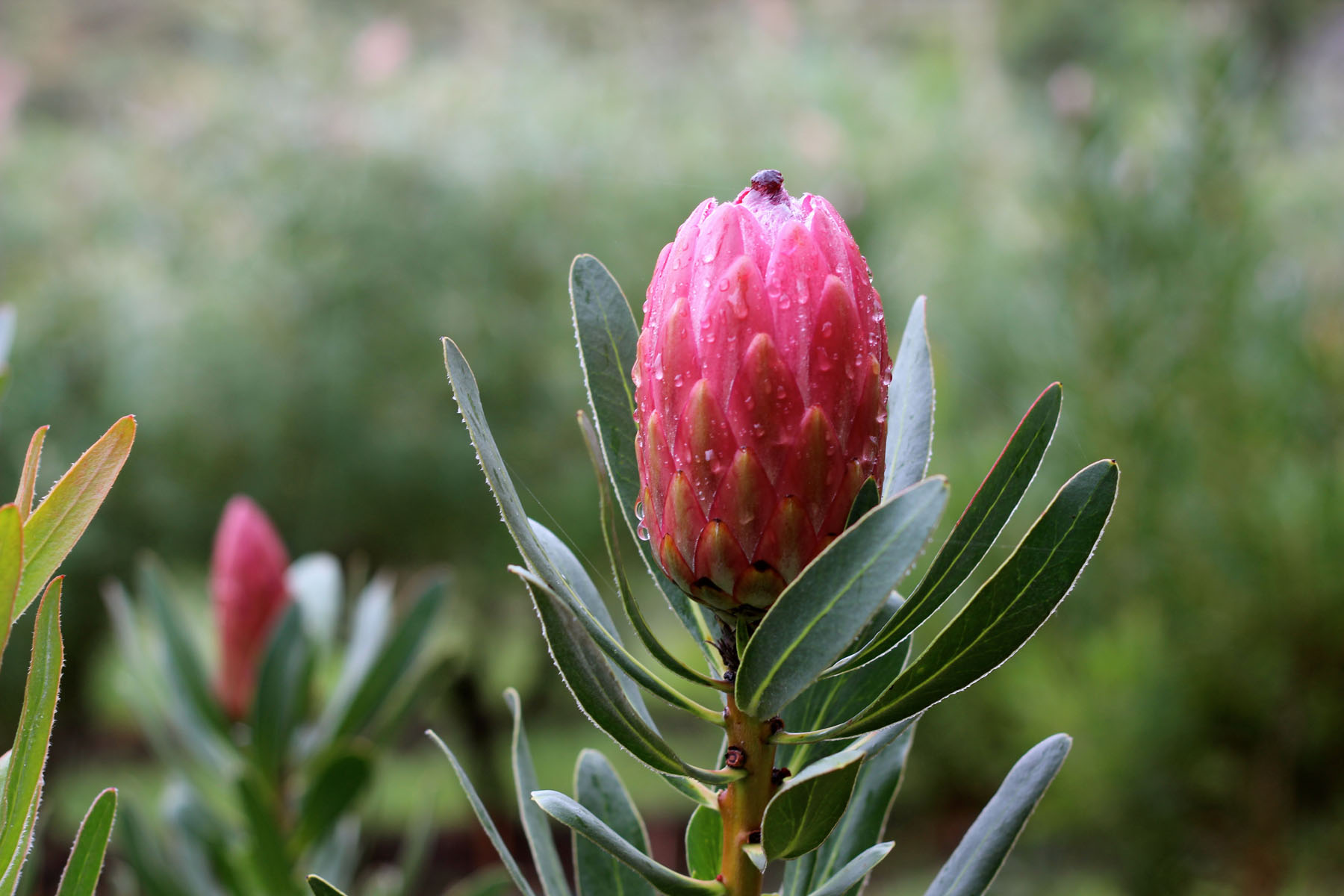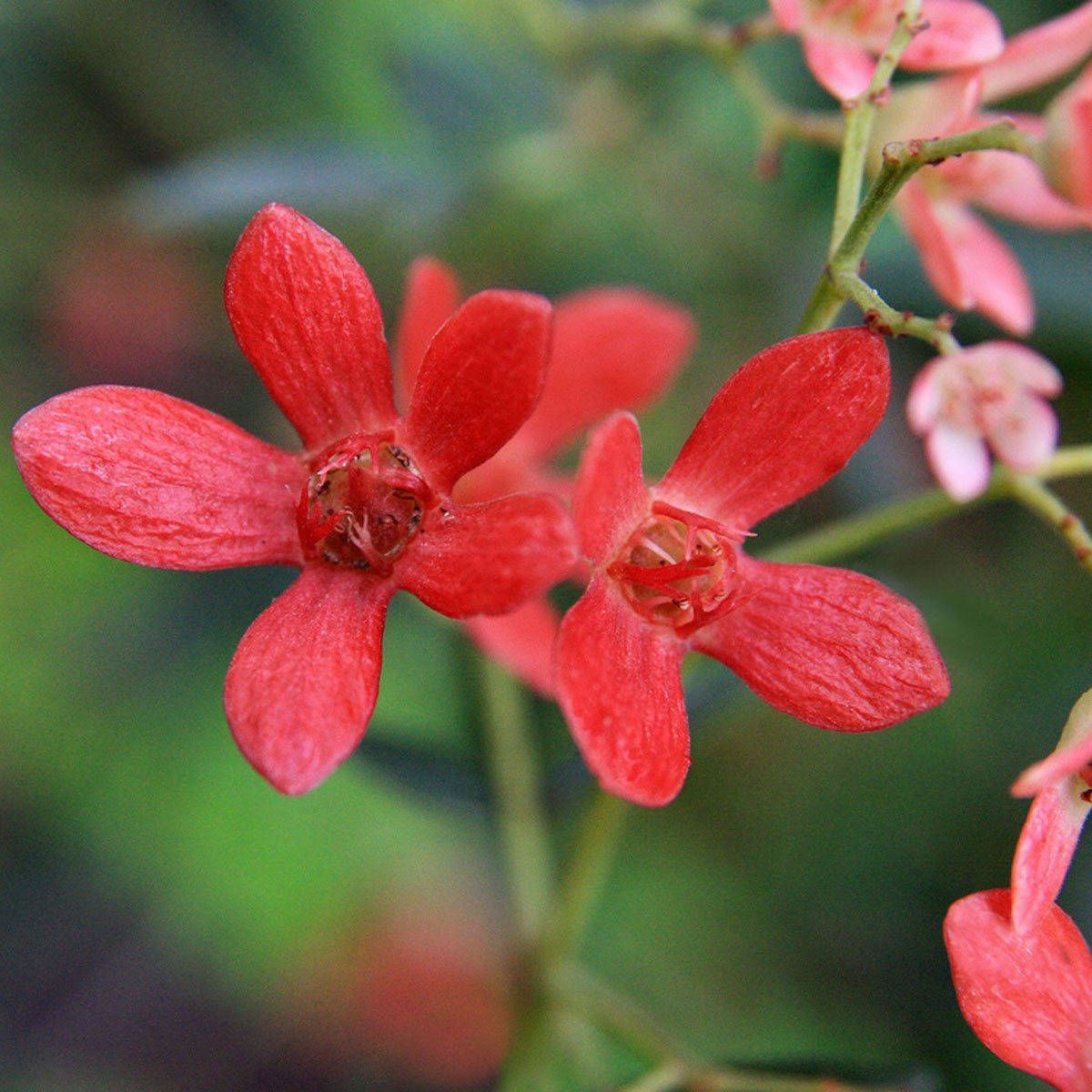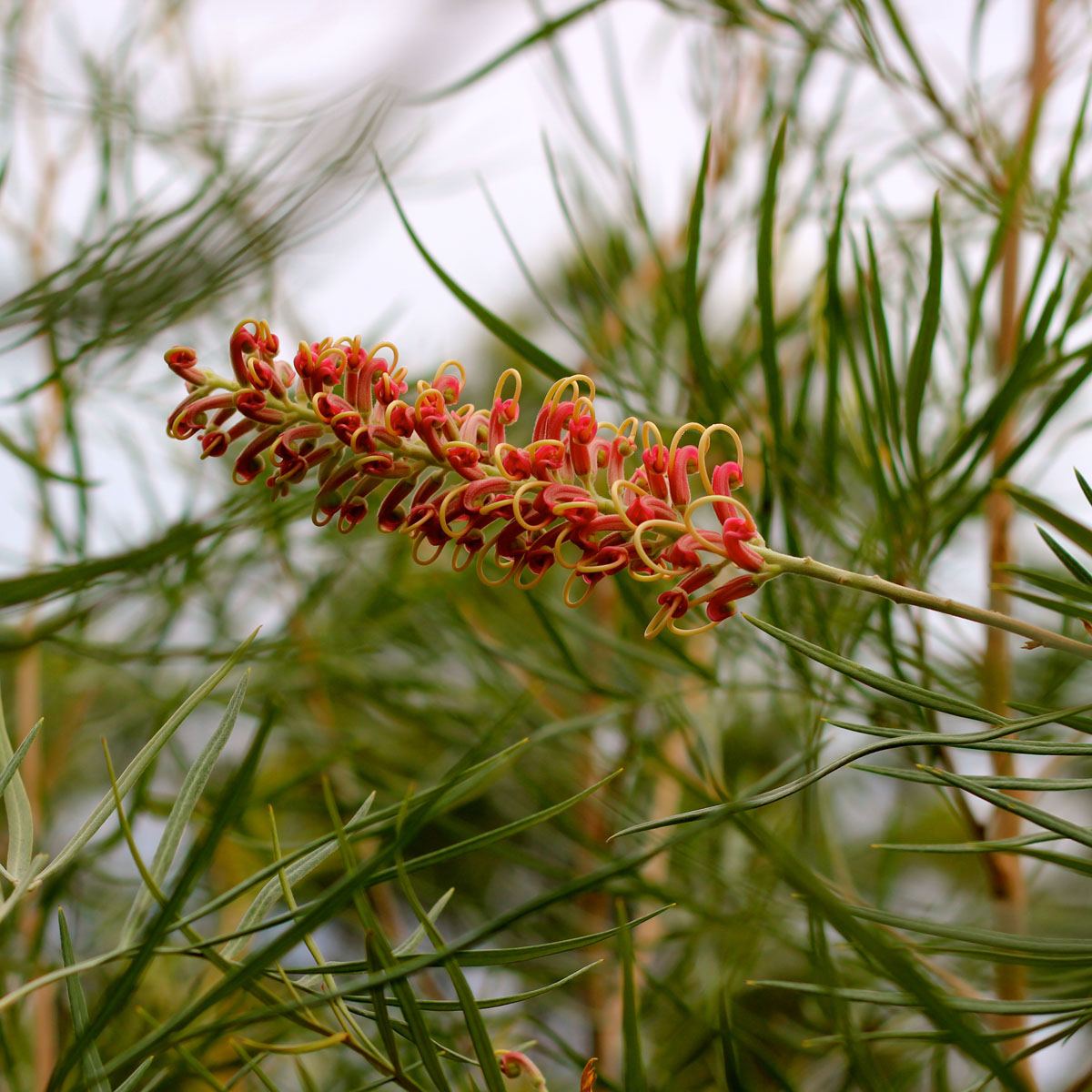Plant-specific growing information
The following pages provide plant-specific information. These are the crops we specialise in:
General information for growing Australian natives
This page provides general information for the successful growth of Australian Native cut flowers. Information regarding growth rates, harvest times and stem yields is specific to plants grown on Australia's east coast. Actual crop performance will vary according to locality, climate, season, site, grower skills and management resources.
plantation basics
GENERAL REQUIREMENTS FOR EASTERN AUSTRALIAN CUT FLOWERS:
- A well-drained site; soil must be free-draining, both on the surface and internally. Roots can only thrive in soil with plenty of air. Test your soil. As your crop matures, you can also test the plant tissue.
- A reliable water supply and irrigation system is essential for good regrowth of stress-free plants and production of long stems with good vase life and development of flowers.
- Plenty of sunshine - minimum of six hours each day in summer and four hours in winter. More sun means better flowers, except for crops that like some shade.
- Plants need mulch to stabilise soil temperatures, prevent drying out and control weeds.
- Protect from frosts and strong winds.
- Layout rows to maximise plant growth - keeping efficient maintenance and harvest operations in mind.
Drainage test
- Dig holes around 30-60cm deep, fill with water. If water has drained away in 6 hours or less, you have reasonable drainage. Normal preparation and raised beds should work. If water has not drained, you have a problem. You can improve drainage by installing slotted pipe drains and / or adding material like coarse sand, gravel, bark & hardwood chips. However, the volume added needs to be considerable - more than 30cm deep over the bed area.
Soil test
- Form a ball of moist soil in your hand, then squash it. Does it crumble (friable) or stick together (clay)? Clay can be treated with gypsum, and most soils will benefit from increased levels of organic matter from biodegradable mulches or green manure crops.
- A professional soil test can be useful if the analyst has experience with Australian plants' physical & nutritional requirements. Test results should include quantitative results to allow comparison with other growers and seasons.
Leaf test
- Leaf sample testing can provide more precise information on what the crop has actually taken up from the soil, and so can be a valuable guide for fertiliser programs. Many Eastern Australian crops are relatively new to cultivation, so there are no long term reference levels for leaf testing. Compare your results with other growers and your own previous results; try to correlate with observation of crop performance.
Nematode test (nematodes are deadly to some Australian natives)
- Lab tests are available but expensive & complex. Take soil samples, at least 6 - 8 from over the whole area. Break up finely and mix thoroughly. Place soil in pots (washed with bleach) on a bench out of contact with the ground. Sow tomato seeds. When the tomato plants are around 5 - 10 weeks old, remove from pots and carefully wash soil off roots. Examine roots for abnormalities like lumps or galls, which probably indicate the presence of nematodes.
Water supply
- Drip irrigation is relatively cheap, very simple to install, durable and reliable. It'll deliver water right where it's needed, with minimum energy output (note: you may be able to use off-peak power for irrigation).
- It's important to match the number of drip outlets to pump capacity, setting up blocks of 'like' plants (eg: same species, age, soil type, aspect). A drip rate of four litres per hour is common for flower crops. Spacing depends on soil type - more porous soils need closer spacings.
- Save many hours of labour with a cheap time-based controller linked to a pump start relay, and optionally, a liquid fertiliser injector. A controller lets you schedule frequent irrigations, so you can water little and often, perhaps four times a day during a summer harvest. This keeps moisture levels more constant which reduces plant stress. You can set watering intervals at a lesser rate when runoff occurs, saving water and power.
- On our shallow rocky podsolic loam in a very dry year (50cm rainfall) we would allow four ML per hectare on six year old Christmas Bush, a crop that needs plenty of water. A normal year (125cm rainfall) would need much less, as would a crop like Riceflower which uses much less. A sandy soil or exposed location would need more water.
- Have your supply tested because your fertiliser program depends on the base level of mineral salts in your water.
Shade crops
- Light shade (30%) cloth is similar to an open forest habitat, and will provide some heat and wind protection with still sufficient light for winter growth.
Nutrition
Basic principles
- Crops need at least 15 mineral elements in the correct proportions for healthy growth. Most of these will not be present in your soil in sufficient quantities to start with - you will need to add and balance. If the land hasn’t been used before, and often if it has, you will most likely benefit from applying ag lime or dolomite, to raise the pH to a level where other nutrients are readily available. Nutrients can be present in soil but unavailable to crops if pH is too low.
- To know what and how much to add before planting, you will need a soil test. Don’t skip this, it’s an excellent investment (see above in basic principles). It’s far easier to remedy problems and optimise soil before planting, because needed amendments can be incorporated into the soil - a process which isn't possible after planting. It's best to ask experienced growers for the most suitable combination of soil test laboratory and soil test recommendations; the two functions are often done by the same company, but don’t have to be. Mainstream farm crop testing services are unlikely to have the expertise to make good recommendations for the diverse range of wildflower crops. There is not much information available on nutrient needs of wildflowers, compared to what’s known about crops like citrus and roses. Also, wildflowers can have quite different needs for and responses to applied nutrients.
- The widely held view that wildflowers are sensitive to phosphorus is mainly wrong; some wildflowers are slightly sensitive to applied phosphorus, for example, and a few are very sensitive, but many respond well. The related view that wildflowers don’t need watering or feeding is also wrong; there is a big difference between plants in the bush, which can remain static with minimal flowering for years, and a commercial crop where we remove big quantities of plant material each year and expect increasing numbers of long stems with big flowers holding lots of carbohydrates for good consumer vase life; for this you need regular monitoring and application of water and nutrients.
- In the first year from planting, you aim for vegetative growth, that is, get the plant big as possible. Controlled release fertiliser with trace elements will be helpful at planting. Any flowers will be on stems that are too short to sell (except for crops that yield early like kangaroo paw and flannels) so best to cut buds off as they appear and concentrate the plant’s energy on growing branches.
- As your crop grows to harvestable size, nutrient needs change on an annual cycle, so a different balance is needed for vegetative growth – branches and leaves – to what’s needed for flowering growth – flower stems, flowers and ‘fruits’. Note some crops have separate flower stems, eg: kangaroo paws, while others have flowers on regular branches, eg: waratah. Also most crops are harvested just before flowers begin to open, eg: banksia, protea or just after first opening, eg: waratah but some must develop ‘fruit’ type structures, which may take two months, before being ready to pick, eg: Christmas bush.
Woody wildflower crop annual growth cycle
- During harvest big quantities of nutrients are removed from the plantation. Some is sold as product, the nutrients contained there are lost to the farm and must be at least replaced, and probably increased in the years before full production, for next year’s harvest. If not replaced, they draw down the soil nutrient reserve. If the soil reserve is high, in a fertile soil, that can go on for some years. If the soil reserve is lower, in a typical eastern Australian bush soil, nutrient deficiency will happen sooner. Either way, nutrients have to be replaced for a sustainable operation. Harvested material not sold – throw-out and trimmings from the packing shed – and pruned material, can be returned to the plantation, directly as mulch if practical, or indirectly, from a ‘compost’ or scrap heap. The degree and speed of nutrient recycling depends on the type of material – soft or woody, its particle size – chipped/shredded or big and chunky, and if it is actually composted, involving a controlled mix of carbon and nitrogen materials which heats up, enhancing the nutrient and microbial content, or just a random heap, allowing nutrient and carbon loss.
- After harvest and pruning the crop starts to regrow stems and foliage. Many crops need stems of a certain size and mass to sustain flowering, stems smaller than the minimum won’t flower until the following year, e.g. protea and banksia. Nitrogen is the predominant nutrient needed at this stage, but no nutrient is sufficient by itself and all must be present at all stages for optimum growth, just the proportions change. Taking Christmas bush as an example, harvest is mostly Nov-Dec in NSW and QLD. Nitrogen, perhaps as chicken manure pellets, which are not so nutrient dense but boost microbial activity, is applied. A slowly soluble complete NPK granular blend including trace elements, such as Nitrophoska 12 – 5 -14, which has much more concentrated nutrients, is also useful. Plants reshoot in January and grow stems, slowly at first, starting from a low base of leaf area, and increasing in growth rate during February and March. On the north coast vegetative growth continues well into April – May. From about the autumn equinox, late March, the required nutrients are less nitrogen and more of the majors, potassium, calcium, and their complimentary minors, boron and zinc. The nutrients all work together, so a shortage of one can cause less absorption of another, likewise with an excess. If one is lacking, the others will not be fully utilised.
- As growth slows but not stops through May and June, foliar applications of calcium and potassium nitrate in alternate weeks will be beneficial. Calcium is synergised by boron, so products containing both in the chelated form are useful. Chelated means bound to an organic base, so not readily leached from plant and soil. Fulvic acid chelates these nitrates and adds to their effect; it is also a powerful microbial stimulant. Flowering is initiated at the cell level around the shortest day and flower buds are visible about 4 weeks later. Calcium and potassium applications continue, with potassium sulphate substituted for nitrate. But foliars are best not used on open flowers because of risk of burning; fulvic acid or other organics may cause foliar discolouration, not a good look close to harvest. After about mid-September plants are fed only water, in increasing amounts.
- Adding fertiliser is a major method for nutrient addition and replacement. Other complimentary methods are adding microbial preparations, which are a new and complex area of sustainable crop care, addressed in another presentation here, and mulch (see below), which can contribute nutrients though its main functions are weed control, moisture retention and carbon boosting.
Fertiliser application methods
- Solid - powder, pelleted, granular fertilisers, e.g. lime, dolomite, gypsum, blends, manures. Not readily soluble. Apply by hand, with bucket and measuring spoon/cup; by spinner spreader, suits small tractor or ATV; by conveyor spreader, for large tractor. Solid applications can be mixed into soil before planting by rotary hoe or cultivator. Soil incorporation is not possible after planting of long-lived crops – most wildflowers - and surface application is the only option, but works more slowly. Solid fertilisers need soil moisture from irrigation or rain to activate. If there is no rain, only the fertiliser in the dripper wetted area will be activated; because the root system may extend beyond, or receive runoff from, that area, precise application timing can be a problem, so for example nitrogen from chicken manure you wanted to be available in January may not be mostly available until rain in March, meaning you will miss out on growth.
- Liquid application gives much better targeted application in space and time. This can be done by fertigation – putting soluble nutrients into the irrigation water, by pressure injection, venturi injection or mixing in a tank. This just puts nutrients in the wetted root zone, so is quite efficient. Nutrients delivered outside the crop root zone will just grow grass – which is a good inter-row cover and traffic surface and much better than bare soil, but too much just means more mowing. Excess nutrients outside of the rows can encourage weed growth, which again is better than bare soil but has its own problems. Fertigation is very labour efficient, as the application, after mixing, is automated with irrigation. Its uptake by roots can be limited by soil temperature and is not much use in high rainfall periods when irrigation is not needed and soil water leaches away.
- Liquid fertilisers – or dissolved solids – can also be foliar applied, sprayed or hosed over the whole plant, with a backpack sprayer for small plants or a spray unit mounted on tractor or ATV. Foliar application is targeted and very nutrient efficient because it covers the young growing tips and developing flower buds, the parts most able to absorb nutrients. Foliar gives the quickest response and can give precise application, eg if you want to apply say 5g per plant over the whole plant, not easy with a solid, and best targeted to tips. Some foliar nutrients can also be mixed with some pesticides, provided compatibility is known or tested; this can reduce need for multiple applications. Care is needed with concentrations of foliars, and time to apply is greater than fertigation.
- In practice, a mixture of all application methods will be appropriate in most plantations.
Mulches
- Organics such as hay, straw, other crop residues like tea tree mulch, cotton trash and bagasse, softwood chips and sawdust are often cheap to buy but can be expensive in labour to apply.
- Good for soil life over time but not always as good at weed suppression. Need to be redone every one to two years as they break down.
- Beware weed seed and too small particle size. Particle size influences both soil aeration and microbial interaction. Small particle sizes break down much quicker and may cause nitrogen depletion.
- Hardwood chips are quite inert and do not break down quickly, providing good weed control. Phenols leeching from hardwood do not seem to be a problem for most native crops, but vary in different timbers, and may have caused problems with some crops. Trial first.
- Weed mat is more expensive upfront but is quick to install and long lasting; does the best job on weed suppression especially in the early years of plantation establishment.
- There may be trade-off between weed suppression and soil nutrition.
Pest and disease management
Weed control
- Weed control is a major expense in maintaining a plantation. Weed control can't be ignored because weeds rob crops of water and fertiliser and also host many pests and diseases.
- Weeds can cause total crop loss in early establishment and severe reductions in yield later.
- Most growers need to use all available control methods at times, including mulching, spraying, mowing, slashing, brushcutting and hand-weeding.
- Systemic herbicides may be transferred to crops by root contact, especially with perennial grass roots, in some circumstances, with deadly results.
- Contact herbicides may be safer for the crop but not as effective in control; they may also be more dangerous to the user.
- Always use herbicides cautiously and follow the label directions. Spray with large controllable droplets only when conditions are suitable.
- Thorough weed control before planting is easier and safer than later.
Frosts
- Growers have prevented frost damage on susceptible crops (especially Christmas Bush) at around - 4°C by spraying Envy™, a polymer anti-transpirant that apparently inhibits the ice nucleating bacteria. The product degrades in around 5-6 weeks, so two or more sprays are used each winter. It seems to give several extra degrees of protection.
Wind
- You won't pick high quality flowers from a windy site.
- Some air movement is beneficial to dry foliage and flowers but crops subjected to frequent strong winds will not look as good and have shorter stems and less vase life.
- Plant a windbreak of hardy local species, preferably before planting your crop. Get local advice on species. Casuarina has been a top performer in windbreaks in NSW.
- You can also build an instant break with cloth, but it needs to be properly designed to take the load.
Plantation layout
Mounded rows provide insurance against plant death from over-wet roots in the exceptionally wet periods common in NE Australia. We recommend mounding in all soils except sands, rocks permitting. Often higher mounds give better growth, because of increased aeration in the root zone. But higher mounds may dry out more in dry times. Mounding on a true contour line can result in water ponding on the high side, so put some fall in the line.
Row layout is affected by land shape, slope, boundaries, access and soil. Often rows are best oriented somewhere between a true contour and directly downhill. Consider erosion risk on steep slopes.
Allow enough space between rows for wheeled vehicle access for spraying and harvesting when crops reach mature size. Allow room to turn around at row ends. Put in cross roads around every 50m, even if rows continue. This speeds operations later.





















